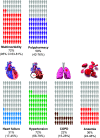Multisystem physiological perspective of human frailty and its modulation by physical activity
- PMID: 36239451
- PMCID: PMC9886361
- DOI: 10.1152/physrev.00037.2021
Multisystem physiological perspective of human frailty and its modulation by physical activity
Abstract
"Frailty" is a term used to refer to a state characterized by enhanced vulnerability to, and impaired recovery from, stressors compared with a nonfrail state, which is increasingly viewed as a loss of resilience. With increasing life expectancy and the associated rise in years spent with physical frailty, there is a need to understand the clinical and physiological features of frailty and the factors driving it. We describe the clinical definitions of age-related frailty and their limitations in allowing us to understand the pathogenesis of this prevalent condition. Given that age-related frailty manifests in the form of functional declines such as poor balance, falls, and immobility, as an alternative we view frailty from a physiological viewpoint and describe what is known of the organ-based components of frailty, including adiposity, the brain, and neuromuscular, skeletal muscle, immune, and cardiovascular systems, as individual systems and as components in multisystem dysregulation. By doing so we aim to highlight current understanding of the physiological phenotype of frailty and reveal key knowledge gaps and potential mechanistic drivers of the trajectory to frailty. We also review the studies in humans that have intervened with exercise to reduce frailty. We conclude that more longitudinal and interventional clinical studies are required in older adults. Such observational studies should interrogate the progression from a nonfrail to a frail state, assessing individual elements of frailty to produce a deep physiological phenotype of the syndrome. The findings will identify mechanistic drivers of frailty and allow targeted interventions to diminish frailty progression.
Keywords: brain; cardiovascular system; exercise; frailty; inflammation.
Conflict of interest statement
No conflicts of interest, financial or otherwise, are declared by the authors.
Figures










References
-
- Office for National Statistics. https://www.ons.gov.uk/peoplepopulationandcommunity/birthsdeathsandmarri....
-
- House of Lords Science and Technology Committee. Ageing: Science, Technology and Healthy Living. https://publications.parliament.uk/pa/ld5801/ldselect/ldsctech/183/18302....
-
- Morley JE, Vellas B, van Kan GA, Anker SD, Bauer JM, Bernabei R, Cesari M, Chumlea WC, Doehner W, Evans J, Fried LP, Guralnik JM, Katz PR, Malmstrom TK, McCarter RJ, Gutierrez Robledo LM, Rockwood K, von Haehling S, Vandewoude MF, Walston J. Frailty consensus: a call to action. J Am Med Dir Assoc 14: 392–397, 2013. doi:10.1016/j.jamda.2013.03.022. - DOI - PMC - PubMed
-
- O’Caoimh R, Galluzzo L, Rodríguez-Laso Á, Van der Heyden J, Ranhoff AH, Lamprini-Koula M, Ciutan M, López-Samaniego LL, Carcaillon-Bentata L, Kennelly S, Liew A; Work Package 5 of the Joint Action ADVANTAGE. Prevalence of frailty at population level in European ADVANTAGE Joint Action Member States: a systematic review and meta-analysis. Ann Ist Super Sanita 54: 226–239, 2018. doi:10.4415/ANN_18_03_10. - DOI - PubMed
-
- Woodhouse KW, Wynne H, Baillie S, James OF, Rawlins MD. Who are the frail elderly? Q J Med 68: 505–506, 1988. - PubMed
Publication types
MeSH terms
Grants and funding
LinkOut - more resources
Full Text Sources

